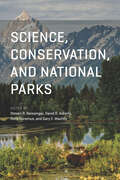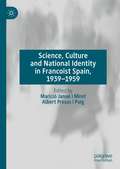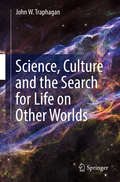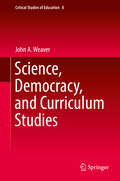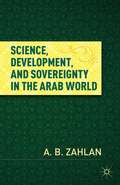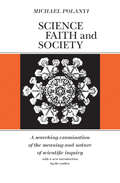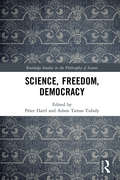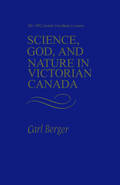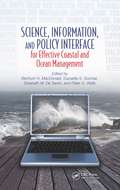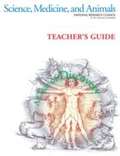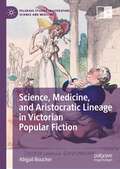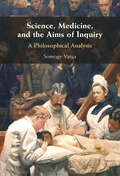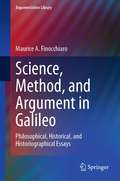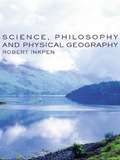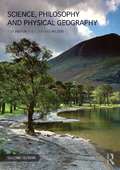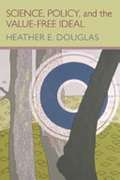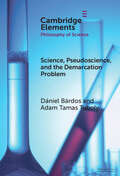- Table View
- List View
Science, Conservation, and National Parks
by Gary E. Machlis David D. Ackerly Holly Doremus Steven R. BeissingerAs the US National Park Service marks its centennial in 2016, parks and protected areas worldwide are under increasing threat from a variety of factors, including storms and fires of greater severity, plant and animal extinctions, the changing attitudes of a public that has become more urbanized, and the political pressures of narrow special interest groups. In the face of such rapid environmental and cultural changes, Science, Conservation, and National Parks gathers a group of renowned scholars—including Edward O. Wilson, Jane Lubchenco, Thomas Dietz, and Monica Turner, among many others—who seek to address these problems and, in so doing, to secure a future for protected areas that will push forward the frontiers of biological, physical, and social science in and for parks. Examining the major challenges of parks and protected areas throughout the world, contributors provide answers to a number of key conservation questions, such as: How should stewardship address climate change, urban encroachment and pollution, and invasive species? How can society, especially youth, become more engaged with nature and parks, and are there models to guide interactions between parks and their neighbors? What are appropriate conservation objectives for parks in the Anthropocene? Charting a course for the parks of the next century, Science, Conservation, and National Parks is certain not only to catalyze the continued evolution of US park conservation policy, but also to be an inspiration for parks, conservation, and management worldwide.
Science, Culture and National Identity in Francoist Spain, 1939–1959
by Marició Janué i Miret Albert Presas i PuigThis book examines the role that science and culture held as instruments of nationalization policies during the first phase of the Franco regime in Spain. It considers the reciprocal relationship between political legitimacy and developments in science and culture, and explores the ‘nationalization’ efforts in Spain in the 1940s and 1950s, via the complex process of transmitting narratives of national identity, through ideas, representations and homogenizing practices. Taking an interdisciplinary approach, the volume features insights into how scientific and cultural language and symbols were used to formulate national identity, through institutions, resource distribution and specific national policies. Split into five parts, the collection considers policies in the Francoist ‘New State’, the role of women in these debates, and perspectives on the nationalization and internationalization efforts that made use of scientific and cultural spheres. Chapters also feature insights into cinema, literature, cultural diplomacy, mathematics and technology in debates on Catalonia, the Nuclear Energy Board, the Spanish National Research Council, and how scientific tools in Spain in this era fed into wider geopolitics with America and onto the UNESCO stage.
Science, Culture and the Search for Life on Other Worlds
by John W. TraphaganThis book explores humanity's thoughts and ideas about extraterrestrial life, paying close attention to the ways science and culture interact with one another to create a context of imagination and discovery related to life on other worlds. Despite the recent explosion in our knowledge of other planets and the seeming era of discovery in which we live, to date we have found no concrete evidence that we are not alone. Our thinking about life on other worlds has been and remains the product of a combination of scientific investigation and human imagination shaped by cultural values--particularly values of exploration and discovery connected to American society. The rapid growth in our awareness of other worlds makes this a crucial moment to think about and assess the influence of cultural values on the scientific search for extraterrestrial life. Here the author considers the junction of science and culture with a focus on two main themes: (1) the underlying assumptions, many of which are tacitly based upon cultural values common in American society, that have shaped the ways researchers in astrobiology and SETI have conceptualized the nature of their endeavor and represented ideas about the potential influence contact might have on human civilization, and (2) the empirical evidence we can access as a way of thinking about the social impact that contact with alien intelligence might have for humanity.
Science, Democracy, and Curriculum Studies (Critical Studies of Education #8)
by John A. WeaverIn this book John A. Weaver suggests curriculum studies scholars need to engage more in science matters. It offers a review of science studies writing from Ludwick Fleck and Thomas Kuhn to Philip Mirowski. The volume includes chapters on the rhetoric of science with a focus on the history of rhetoric and economics then on the rhetoric of models, statistics, and data, a critique of neoliberalism and its impact on science policy and the foundations of democracy, Harry Collin’s and Robert Evans’ theory of expertise followed by chapters on feminism with a focus on the work of Sharon Traweek, Karen Barad, and Vinciane Despret, postcolonial thought, with attention paid to the work of Daniela Bleichmar, Londa Schiebinger, Judith Carney, Sylvia Wynter, Paul Gilroy, and Sandra Harding, and a final chapter on Nietzsche’s philosophy of science. Each section is introduced by an interlude drawing on autobiographical connections between curriculum studies and science studies.
Science, Development, and Sovereignty in the Arab World
by A. B. ZahlanZahlan's detailed study examines recent and current performance of Arab countries and their organizations in scientific research in relation to their socio-economic development. It shows that the Arab countries are severely handicapped by a political economy dominated by technological dependence, corruption, and limited research collaboration.
Science, Evidence, and Inference in Education: Report of a Workshop
by National Academy PressThe National Academies Press (NAP)--publisher for the National Academies--publishes more than 200 books a year offering the most authoritative views, definitive information, and groundbreaking recommendations on a wide range of topics in science, engineering, and health. Our books are unique in that they are authored by the nation's leading experts in every scientific field.
Science, Evolution And Creationism
by Institute of Medicine National Academy Of SciencesHow did life evolve on Earth? The answer to this question can help us understand our past and prepare for our future. Although evolution provides credible and reliable answers, polls show that many people turn away from science, seeking other explanations with which they are more comfortable. In the book Science, Evolution, and Creationism, a group of experts assembled by the National Academy of Sciences and the Institute of Medicine explain the fundamental methods of science, document the overwhelming evidence in support of biological evolution, and evaluate the alternative perspectives offered by advocates of various kinds of creationism, including "intelligent design." The book explores the many fascinating inquiries being pursued that put the science of evolution to work in preventing and treating human disease, developing new agricultural products, and fostering industrial innovations. The book also presents the scientific and legal reasons for not teaching creationist ideas in public school science classes. Mindful of school board battles and recent court decisions, Science, Evolution, and Creationism shows that science and religion should be viewed as different ways of understanding the world rather than as frameworks that are in conflict with each other and that the evidence for evolution can be fully compatible with religious faith. For educators, students, teachers, community leaders, legislators, policy makers, and parents who seek to understand the basis of evolutionary science, this publication will be an essential resource.
Science, Faith and Society
by Michael PolanyiIn its concern with science as an essentially human enterprise, Science, Faith and Society makes an original and challenging contribution to the philosophy of science. On its appearance in 1946 the book quickly became the focus of controversy. Polanyi aims to show that science must be understood as a community of inquirers held together by a common faith; science, he argues, is not the use of "scientific method" but rather consists in a discipline imposed by scientists on themselves in the interests of discovering an objective, impersonal truth. That such truth exists and can be found is part of the scientists' faith. Polanyi maintains that both authoritarianism and scepticism, attacking this faith, are attacking science itself.
Science, Faith and Society: A searching examination of the meaning and nautre of scientific inquiry
by Michael PolanyiIn its concern with science as an essentially human enterprise, Science, Faith and Society makes an original and challenging contribution to the philosophy of science. On its appearance in 1946 the book quickly became the focus of controversy. Polanyi aims to show that science must be understood as a community of inquirers held together by a common faith; science, he argues, is not the use of "scientific method" but rather consists in a discipline imposed by scientists on themselves in the interests of discovering an objective, impersonal truth. That such truth exists and can be found is part of the scientists' faith. Polanyi maintains that both authoritarianism and scepticism, attacking this faith, are attacking science itself.
Science, Fiction, and the Fin-de-Siècle Periodical Press (Cambridge Studies in Nineteenth-Century Literature and Culture)
by Will TattersdillIn this revisionary study, Will Tattersdill argues against the reductive 'two cultures' model of intellectual discourse by exploring the cultural interactions between literature and science embodied in late nineteenth-century periodical literature, tracing the emergence of the new genre that would become known as 'science fiction'. He examines a range of fictional and non-fictional fin-de-siècle writing around distinct scientific themes: Martian communication, future prediction, X-rays, and polar exploration. Every chapter explores a major work of H. G. Wells, but also presents a wealth of exciting new material drawn from a variety of late Victorian periodicals. Arguing that the publications in which they appeared, as well as the stories themselves, played a crucial part in the development of science fiction, Tattersdill uses the form of the general interest magazine as a way of understanding the relationship between the arts and the sciences, and the creation of a new literary genre. Provides analysis of some of H. G. Wells's most famous writings, showing them in an entirely new light when placed back in their periodical context Challenges the 'two cultures' model of intellectual discourse by exploring the cultural interactions between literature and science Proposes a new view of the importance of periodicals as a
Science, Freedom, Democracy (Routledge Studies in the Philosophy of Science)
by Péter HartlThis book addresses the complex relationship between the values of liberal democracy and the values associated with scientific research. The chapters explore how these values mutually reinforce or conflict with one another, in both historical and contemporary contexts. The contributors utilize various approaches to address this timely subject, including historical studies, philosophical analysis, and sociological case studies. The chapters cover a range of topics including academic freedom and autonomy, public control of science, the relationship between scientific pluralism and deliberative democracy, lay-expert relations in a democracy, and the threat of populism and autocracy to scientific inquiry. Taken together the essays demonstrate how democratic values and the epistemic and non-epistemic values associated with science are interconnected. Science, Freedom, Democracy will be of interest to scholars and graduate students working in philosophy of science, history of philosophy, sociology of science, political philosophy, and epistemology.
Science, God, and Nature in Victorian Canada: The 1982 Joanne Goodman Lectures
by Carl BergerProfessor Berger aims in this book to 'explore the rise, expression, and relative decline of the idea of natural history' in Canada, during the age of Victoria. Science, particularly natural science, was then accessible to the general public in a way scarcely imaginable today. Natural history societies were set up in a number of cities and provided a focus for the descriptive and collecting activities of amateurs and incipient professionals. These societies acted as social clubs and vehicles for self-improvement as well as providing excellent training for the amateur scientist. The Baconian assumptions that inspired the Victorian collectors and scientists were one of the major victims of the Darwinian revolution, and their demise brought about the gradual decline of the natural history societies. Professor Berger considers also the sense of wonder and reverence with which Victorian Canadians, like their British contemporaries, looked at the varieties and delights of nature. The British tradition of natural theology had a great impact on the pursuit of science in Victorian Canada, leading naturalists and poets alike to seek in the uncharted flora and fauna of their new land the handiwork of a benevolent God. The author examines the impact of the discoveries of Darwin on this tradition and on the relations between science and religion, as the creator and the act of creation became more and more distant in time and more tenuously connected to the world of nature around us.His study provides many rich insights into the practice and theory of natural history in an age when even a veteran politician could look back and recall, with understanding and in detail, the world of nature in the countryside of his youth.
Science, Information, and Policy Interface for Effective Coastal and Ocean Management
by Bertrum H. MacDonaldThis book provides a timely analysis of the role that information-particularly scientific information-plays in the policy-making and decision-making processes in coastal and ocean management. It includes contributions from global experts in marine environmental science, marine policy, fisheries, public policy and administration, resource management
Science, Level 3 (California Edition)
by Marjorie Slavick Frank Robert M. Jones Gerald H. Krockover Mozell P. Lang Joyce C. Mcleod Carol J. Valenta Barry A. Van DemanThe book covers topic like "Living Things Grow and Change", "Animals Grow and Change ", "People Grow and Change", "Exploring Earth's Surface", Earth's Resources, Earth Long Ago, Matter and Motion.
Science, Level 4 (California Edition)
by Marjorie Slavick Frank Robert M. Jones Gerald H. Krockover Mozell P. Lang Joyce C. Mcleod Carol J. Valenta Barry A. Van DemanFind answers to questions like--What Are the Basic Needs of Animals?, How Do Animals' Body Parts Help Them Meet Their Needs?, What Do Plants Need to Live?, How Do Leaves, Stems, and Roots Help Plants Live?, How Do Plants Reproduce?, What Are Ecosystems?, How Does Energy Flow Through an Ecosystem? and much more information on how Earth's surface has changed, how mountains, volcanoes and earthquakes were formed. A very informative book for students studying science.
Science, Level 5 (California Edition)
by Marjorie Slavick Frank Robert M. Jones Gerald H. Krockover Mozell P. Lang Joyce C. Mcleod Carol J. Valenta Barry A. Van DemanFind answers to questions like What Are Cells, and What Do They Do?, How Do Bones, Muscles, and Nerves Work Together?, How Do Scientists Classify Living Things?, What Are the Functions of Roots, Stems, and Leaves?, How Do Plants Make Food? and many more.
Science, Medicine, and Animals
by Institute Of Laboratory Animal Research StaffScience, Medicine, and Animals explains the role that animals play in biomedical research and the ways in which scientists, governments, and citizens have tried to balance the experimental use of animals with a concern for all living creatures. An accompanying Teacher’s Guide is available to help teachers of middle and high school students use Science, Medicine, and Animals in the classroom. As students examine the issues in Science, Medicine, and Animals, they will gain a greater understanding of the goals of biomedical research and the real-world practice of the scientific method in general. Science, Medicine, and Animals and the http://www.nap.edu/catalog/11564.html Teacher's Guide were written by the Institute for Laboratory Animal Research and published by the National Research Council of the National Academies. The report was reviewed by a committee made up of experts and scholars with diverse perspectives, including members of the U.S. Department of Agriculture, National Institutes of Health, the Humane Society of the United States, and the American Society for the Prevention of Cruelty to Animals. The Teacher’s Guide was reviewed by members of the National Academies’ Teacher Associates Network. Science, Medicine, and Animals is recommended by the http://www2.nsta.org/recommends/product.asp?id=15858 National Science Teacher's Association.
Science, Medicine, and Animals: A Circle of Discovery
by National Research Council of the National Academieshttp://www.nap.edu/catalog/10733.html Science, Medicine, and Animals explains the role that animals play in biomedical research and the ways in which scientists, governments, and citizens have tried to balance the experimental use of animals with a concern for all living creatures. An accompanying Teacher’s Guide is available to help teachers of middle and high school students use Science, Medicine, and Animals in the classroom. As students examine the issues in Science, Medicine, and Animals, they will gain a greater understanding of the goals of biomedical research and the real-world practice of the scientific method in general. Science, Medicine, and Animals and the Teacher’s Guide were written by the Institute for Laboratory Animal Research and published by the National Research Council of the National Academies. The report was reviewed by a committee made up of experts and scholars with diverse perspectives, including members of the U.S. Department of Agriculture, National Institutes of Health, the Humane Society of the United States, and the American Society for the Prevention of Cruelty to Animals. The Teacher’s Guide was reviewed by members of the National Academies’ Teacher Associates Network. Science, Medicine, and Animals is recommended by the National Science Teacher’s Association http://www2.nsta.org/recommends/product.asp?id=15858NSTA Recommends.
Science, Medicine, and Aristocratic Lineage in Victorian Popular Fiction (Palgrave Studies in Literature, Science and Medicine)
by Abigail BoucherScience, Medicine, and Lineage in Popular Fiction of the Long Nineteenth Century explores the dialogue between popular literature and medical and scientific discourse in terms of how they represent the highly visible an pathologized British aristocratic body. This books explores and complicates the two major portrayals of aristocrats in nineteenth-century literature: that of the medicalised, frail, debauched, and diseased aristocrat, and that of the heroic, active, beautiful ‘noble’, both of which are frequent and resonant in popular fiction of the long nineteenth century. Abigail Boucher argues that the concept of class in the long nineteenth century implicitly includes notions of blood, lineage, and bodily ‘correctness’, and that ‘class’ was therefore frequently portrayed as an empirical, scientific, and medical certainty. Due to their elevated and highly visual social positions, both historical and fictional aristocrats were frequently pathologized in the public mind and watched for signs of physical excellence or deviance. Using popular fiction, Boucher establishes patterns across decades, genres, and demographics and considers how these patterns react to, normalise, or feed into the advent of new scientific and medical understandings.
Science, Medicine, and the Aims of Inquiry: A Philosophical Analysis
by Somogy VargaAfter its unparalleled rise and expansion over the past century, medicine is increasingly criticized both as a science and clinical practice for lacking scientific rigor, for contributing to overmedicalization, and for failing to offer patient-centered care. This criticism highlights serious challenges which indicate that the scope and societal role of medicine are likely to be altered in the 21st century. Somogy Varga's ground-breaking book offers a new perspective on the challenges, showing that they converge on fundamental philosophical questions about the nature and aim of medicine. Addressing these questions, Varga presents a philosophical examination of the norms and values constitutive of medicine and offers new perspectives on how to address the challenges that the criticism raises. His book will offer valuable input for rethinking the agenda of medical research, health care delivery, and the education of health care personnel.
Science, Method, and Argument in Galileo: Philosophical, Historical, and Historiographical Essays (Argumentation Library #40)
by Maurice A. FinocchiaroThis book collects a renowned scholar's essays from the past five decades and reflects two main concerns: an approach to logic that stresses argumentation, reasoning, and critical thinking and that is informal, empirical, naturalistic, practical, applied, concrete, and historical; and an interest in Galileo’s life and thought—his scientific achievements, Inquisition trial, and methodological lessons in light of his iconic status as “father of modern science.” These republished essays include many hard to find articles, out of print works, and chapters which are not available online. The collection provides an excellent resource of the author's lifelong dedication to the subject. Thus, the book contains critical analyses of some key Galilean arguments about the laws of falling bodies and the Copernican hypothesis of the earth’s motion. There is also a group of chapters in which Galileo’s argumentation is compared and contrasted with that of other figures such as Socrates, Karl Marx, Giordano Bruno, and his musicologist father Vincenzo Galilei. The chapters on Galileo’s trial illustrate an approach to the science-vs-religion issue which Finocchiaro labels “para-clerical” and conceptualizes in terms of a judicious consideration of arguments for and against Galileo and the Church. Other essays examine argumentation about Galileo’s life and thought by the major Galilean scholars of recent decades. The book will be of interest to scholars in philosophy, logic, philosophy of science, history of science, history of religion, philosophy of religion, argumentation, rhetoric, and communication studies.
Science, Philosophy and Physical Geography
by Robert Inkpen Graham WilsonThis accessible and engaging text explores the relationship between philosophy, science and physical geography. It addresses an imbalance that exists in opinion, teaching and to a lesser extent research, between a philosophically enriched human geography and a perceived philosophically ignorant physical geography.Science, Philosophy and Physical Geography, challenges the myth that there is a single self-evident scientific method, that can and is applied in a straightforward manner by physical geographers. It demonstrates the variety of alternative philosophical perspectives. Furthermore it emphasizes the difference that the real world geographical context and the geographer make to the study of environmental phenomenon. This includes a consideration of the dynamic relationship between human and physical geography. Finally, it demonstrates the relevance of philosophy for both an understanding of published material and for the design and implementation of studies in physical geography. Key themes such as global warming, species and evolution and fluvial geomorphology are used to provide illustrations of key concepts in each chapter. Further reading is provided at the end of each chapter.
Science, Philosophy and Physical Geography
by Robert Inkpen Graham WilsonThis accessible and engaging text explores the relationship between philosophy, science and physical geography. It addresses an imbalance that exists in opinion, teaching and to a lesser extent research, between a philosophically enriched human geography and a perceived philosophically empty physical geography. The text challenges the myth that there is a single self-evident scientific method that can, and is, applied in a straightforward manner by physical geographers. It demonstrates the variety of alternative philosophical perspectives and emphasizes the difference that the real world geographical context and the geographer make to the study of environmental phenomenon. This includes a consideration of the dynamic relationship between human and physical geography. Finally, the text demonstrates the relevance of philosophy for both an understanding of published material and for the design and implementation of studies in physical geography. This edition has been fully updated with two new chapters on field studies and modelling, as well as greater discussion of ethical issues and forms of explanation. The book explores key themes such as reconstructing environmental change, species interactions and fluvial geomorphology, and is complimented throughout with case studies to illustrate concepts.
Science, Policy, And The Value-free Ideal
by Heather DouglasThe role of science in policymaking has gained unprecedented stature in the United States, raising questions about the place of science and scientific expertise in the democratic process. Some scientists have been given considerable epistemic authority in shaping policy on issues of great moral and cultural significance, and the politicizing of these issues has become highly contentious. Since World War II, most philosophers of science have purported the concept that science should be “value-free.” In Science, Policy and the Value-Free Ideal, Heather E. Douglas argues that such an ideal is neither adequate nor desirable for science. She contends that the moral responsibilities of scientists require the consideration of values even at the heart of science. She lobbies for a new ideal in which values serve an essential function throughout scientific inquiry, but where the role values play is constrained at key points, thus protecting the integrity and objectivity of science. In this vein, Douglas outlines a system for the application of values to guide scientists through points of uncertainty fraught with moral valence. Following a philosophical analysis of the historical background of science advising and the value-free ideal, Douglas defines how values should-and should not-function in science. She discusses the distinctive direct and indirect roles for values in reasoning, and outlines seven senses of objectivity, showing how each can be employed to determine the reliability of scientific claims. Douglas then uses these philosophical insights to clarify the distinction between junk science and sound science to be used in policymaking. In conclusion, she calls for greater openness on the values utilized in policymaking, and more public participation in the policymaking process, by suggesting various models for effective use of both the public and experts in key risk assessments.
Science, Pseudoscience, and the Demarcation Problem (Elements in the Philosophy of Science)
by Adam Tamas Tuboly Dániel BárdosThis Element examines various aspects of the demarcation problem: finding a distinction between science and pseudoscience. Section 1 introduces issues surrounding pseudoscience in the recent literature. Popper's falsificationism is presented in Section 2, alongside some of its early critics, such as Thomas Kuhn and Imre Lakatos. It is followed in Section 3 by the notable criticism of the Popperian program by Larry Laudan that put the issue out of fashion for decades. Section 4 explores recent multi-criteria approaches that seek to define pseudoscience not only along a single criterion, but by considering the diversity and historical dimension of science. Section 5 introduces the problem of values (the 'new demarcation problem') and addresses how we can use values in the problem of pseudoscience. Finally, Section 6 concludes by emphasizing the need for an attitude-oriented approach over a rigid, method-based demarcation, recognizing scientific practice's evolving and multifaceted nature.
